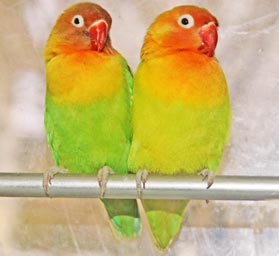
Lovebirds are one of the most affectionate and charming pets anyone can own. They’re very sociable, and will chirp happily when someone walks into the room. They also mate for life (lifespan is usually 10 to 15 years), and may even pine away if a partner passes on. For this reason, love birds have become a symbol of devotion and the eternal bond between two people.
Lovebirds-Love in many languages
Different cultures give different names to lovebirds, but the words always refer to their bonds with their mates. The scientific name, Agapornis is a direct translation of love bird, while the French call them les insיparables or the inseparables. Mates will sit very close to each other, even when nesting or sleeping. You can often find them grooming each other, fluffing each other’s feathers with gentle “kisses”.
This is why most people think that all lovebirds must be kept in pairs if they are in captivity. This isn’t actually true. You can keep one bird, but be prepared to shower it with a lot of affection—in effect, you become its “partner.”
Lovebirds-Physical appearance
Lovebirds are among the small parrots in the world. They are usually about 13 centimeters high; very few grow past 17 centimeters. They weigh about 40 to 60 grams, which gives them a stocky build. They have a very short, wedge-shaped tail, and (compared to the rest of its body) a large beak. Females are usually a little larger than males.
Most lovebirds are green, although breeders have successfully developed many color mutations. The Fischer’s variety has black cheeks, while the yellow-collared lovebird has an interesting white ring encircling its eye. However, there are also cinnamon lovebirds, lutinos, dutch blues, and the creaminos.
Types of Lovebirds
The first record of lovebirds dates back to the 1600s. Travelers brought back reports of red faced birds that populated the forests and lakes of Africa. Since then many lovebird varieties have been discovered. There is the Madagascar lovebird, found in the island republic of Malagasy. The black cheeked lovebird is endemic only to Zimbabwe, while the masked lovebird makes it home in northeast Tanzania
The peach-faced lovebird was once thought to be a mutation of the red-faced lovebird, but was recognized as a separate species in 1817. Since this variety is easy to breed in captivity, it is a common sight in pet stores and households around the world.
There are some lovebird varieties that are so rare that it is difficult to import them or sell them as pets. This includes the Abyssinian lovebird which lives in the high mountains of Ethiopia and southern Entrea. The Swindern Lovebird is found in Liberia, Zaire, and the Camaroons.